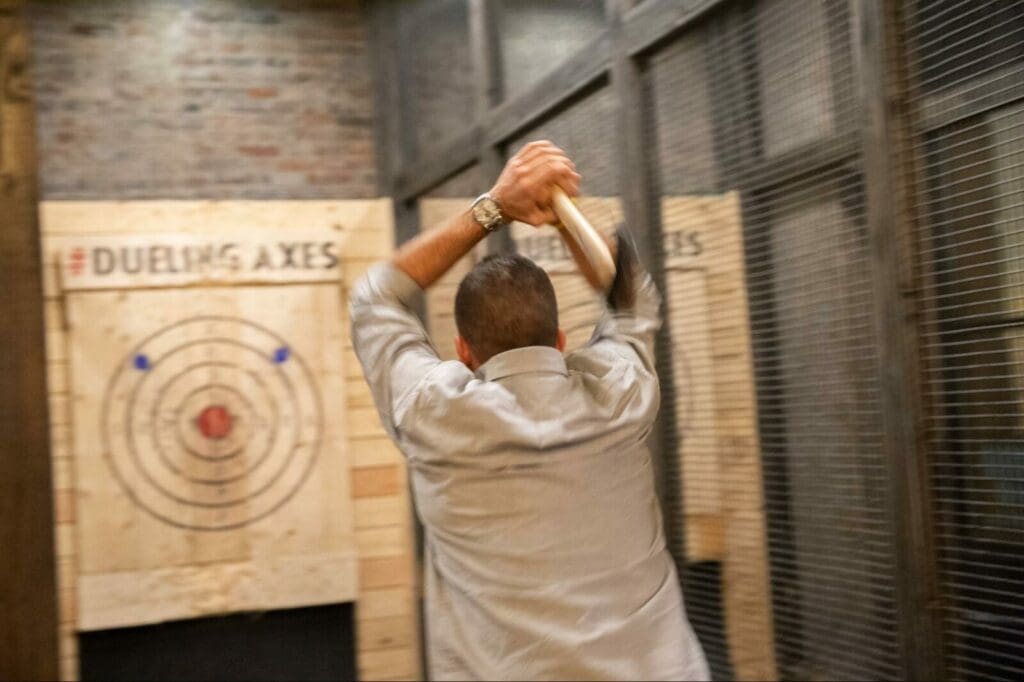The Fun of Axe Throwing: How This Sporting Activity Incorporates Skill and Adrenaline for a Great Time
Axe throwing has arised as an astounding sport that masterfully links the requirement for exact ability with the thrill of adrenaline, offering participants a interesting and one-of-a-kind experience. The act of tossing an axe towards a target demands focus and strategy, all at once fostering an environment of friendship and pleasant rivalry. This interesting blend of psychological emphasis and physical effort has actually made axe tossing a preferred option for those seeking both leisure and a feeling of accomplishment. To genuinely appreciate the deepness and charm of this task, one need to consider its origins, the needed tools, and the foundational strategies that ensure both safety and security and satisfaction.
The Beginnings of Axe Throwing
Axe tossing, an entertainment task that has actually obtained considerable appeal in current years, traces its roots back to old times. The earliest records of axe usage in affordable contexts are discovered amongst the Celts and Vikings, that tossed axes for sporting activity as well as in combat training.
Medieval European warriors, specifically throughout the Center Ages, exercised axe throwing as part of their martial training. The Francisca, a sort of tossing axe made use of by the Franks, came to be renowned for its dangerous accuracy. This standard tool was made to be thrown at adversary shields and armor, showcasing its double energy in both sport and fight.
In even more recent background, axe tossing saw a revival in the logging camps of The United States and copyright in the 19th and 20th centuries. Lumberjacks would certainly involve in pleasant competition, examining their accuracy and stamina by aiming at wooden targets. This development from a survival ability to a leisure activity has actually led the way for its modern-day revival, with specialized locations and leagues now commemorating the sport worldwide.
Tools You Need
Comprehending the rich background of axe throwing improves the recognition of the sport's modern-day model. For entertainment and competitive axe throwing, the most generally utilized type is the hatchet, typically considering between 1.25 to 2 pounds with a handle size of about 16 inches.
Equally essential is the target. Regulation targets are constructed from wood, with softwood selections like yearn or cottonwood being chosen for their ability to absorb and hold the axe. The target is usually divided right into five concentric circles, each with a particular factor value, to promote scoring.
Safety equipment, however usually overlooked, is essential. Safety gloves can enhance grip and prevent blisters, while closed-toed footwear are a must to secure feet from gone down axes (axe throwing denver). Finally, a well-lit, roomy tossing location, complete with safety and security obstacles, guarantees a regulated environment where participants can focus on developing their abilities.
Basic Techniques Discussed
Grasping the essential techniques of axe throwing is crucial for both security and efficiency. The first strategy to understand is the grip. Hold the axe with a company, yet relaxed hold, comparable to holding a golf club. The leading hand should be placed straight below the axe head, while the non-dominant hand supports completion of the manage.
Next, focus on the position. Stand with your feet shoulder-width apart, guaranteeing your body is balanced. Your leading foot should be a little ahead, lining up with your target. This positioning help in keeping security and directing power properly towards the target.

Safety First
Ensuring safety in axe throwing is extremely important to developing a delightful and injury-free experience. Precaution start with the location layout. A well-designed axe tossing center functions clear demarcations in between throwing lanes, tough backdrops to catch roaming axes, and non-slip floor covering to stop accidents. In addition, adequate lighting is critical to help participants keep aesthetic precision and spatial awareness.
Benefits of Axe Throwing
Axe throwing offers a myriad of benefits that expand beyond basic recreation. The repeated activity of throwing the axe also enhances hand-eye control and fine electric motor abilities.
Psychologically, axe tossing needs accuracy, method, and focus, making it an outstanding means to hone cognitive abilities. The focus required to hit the target can offer as a kind of mindfulness, enabling individuals to remove their minds and decrease anxiety. This mental engagement can be particularly helpful in helping individuals develop much better analytic abilities and psychological durability.
Socially, axe throwing is frequently enjoyed in group setups, cultivating team-building and sociability. Whether as component of a company occasion or an informal getaway with buddies, the sporting activity encourages communication and partnership. Furthermore, the public experience of discovering and enhancing together can enhance relationships and create enduring memories.
Verdict

The earliest documents of axe use in affordable contexts are located amongst the Celts and Vikings, who threw axes for sporting activity as well as in combat training. Launch Look At This the axe when your hands are roughly at eye level, allowing the axe's natural turning to direct it in the direction of the target.
A well-designed axe tossing center features clear separations between tossing lanes, tough backgrounds to catch stray axes, and non-slip floor covering to avoid mishaps. Individuals have to be advised on the right means to deal with and throw the axe, stressing regulated, deliberate activities over forceful tosses.
In summary, axe throwing stands out as a view publisher site sport that masterfully integrates precision, ability, and adrenaline.